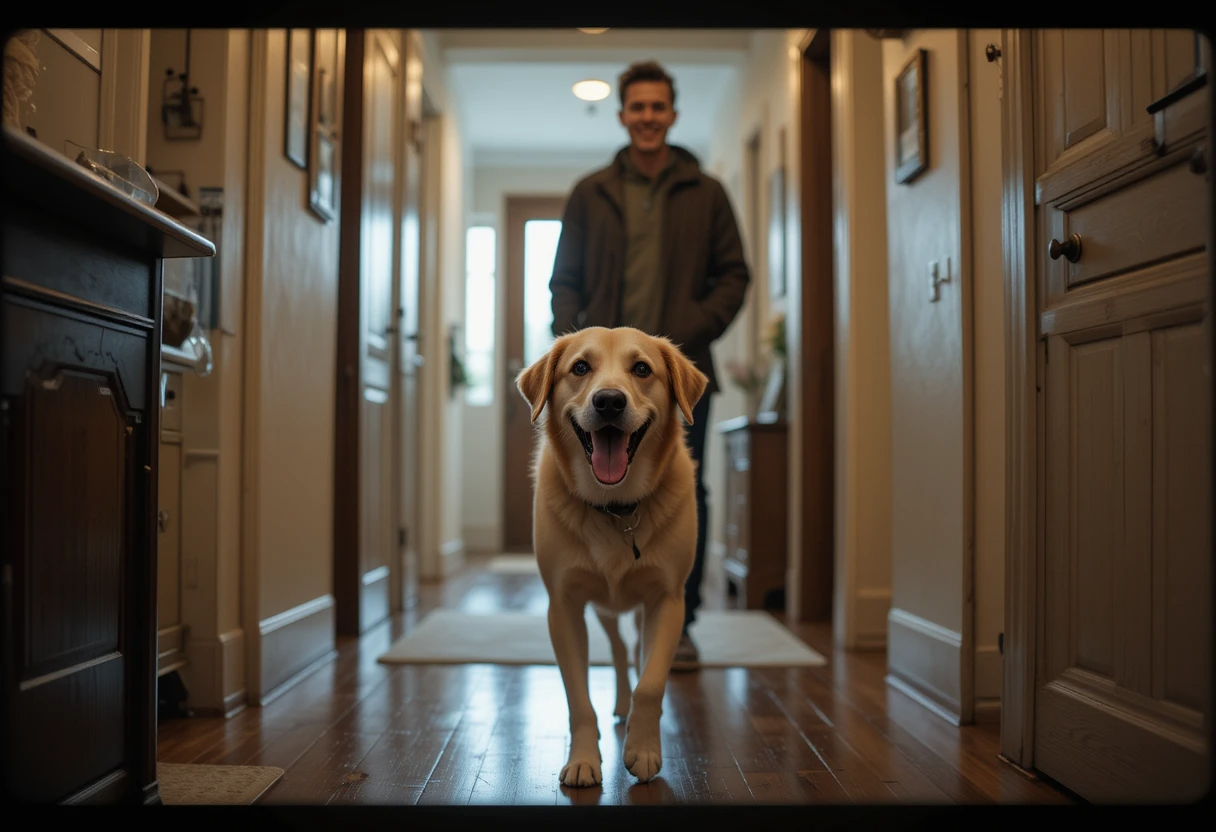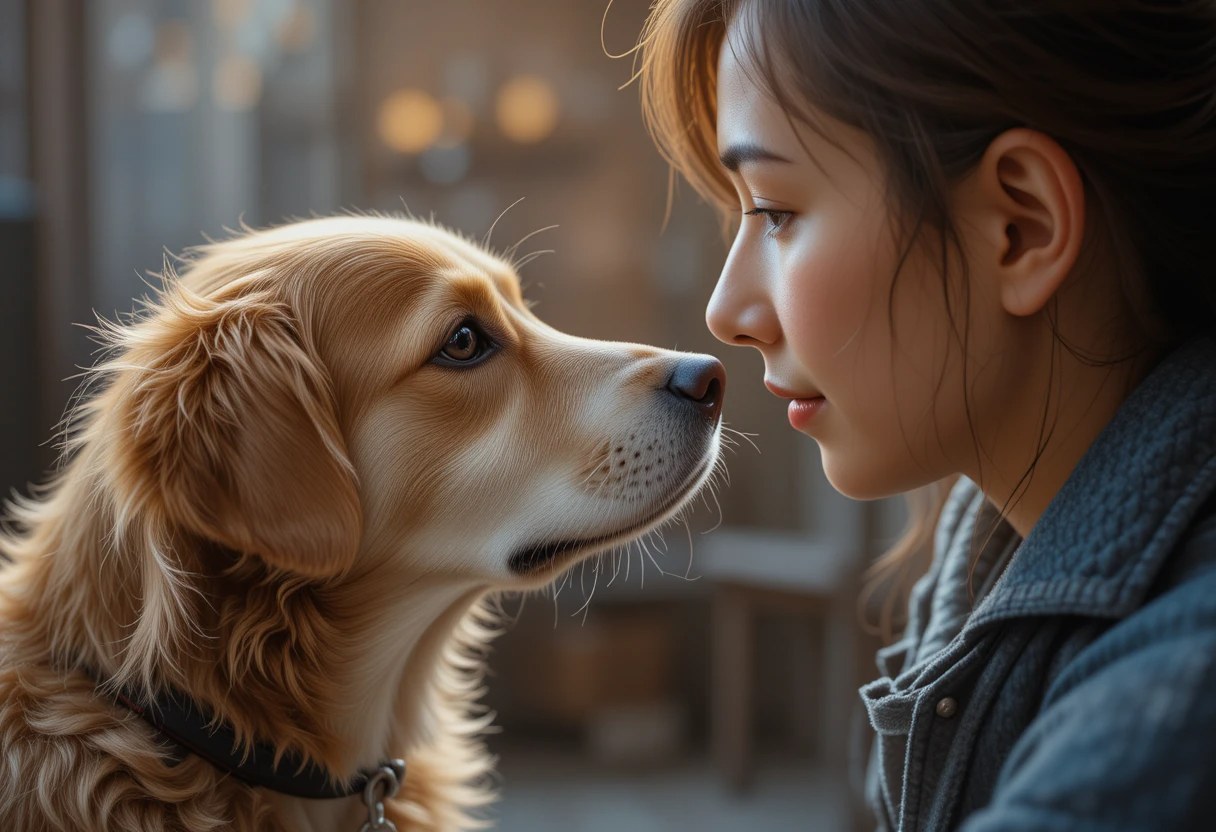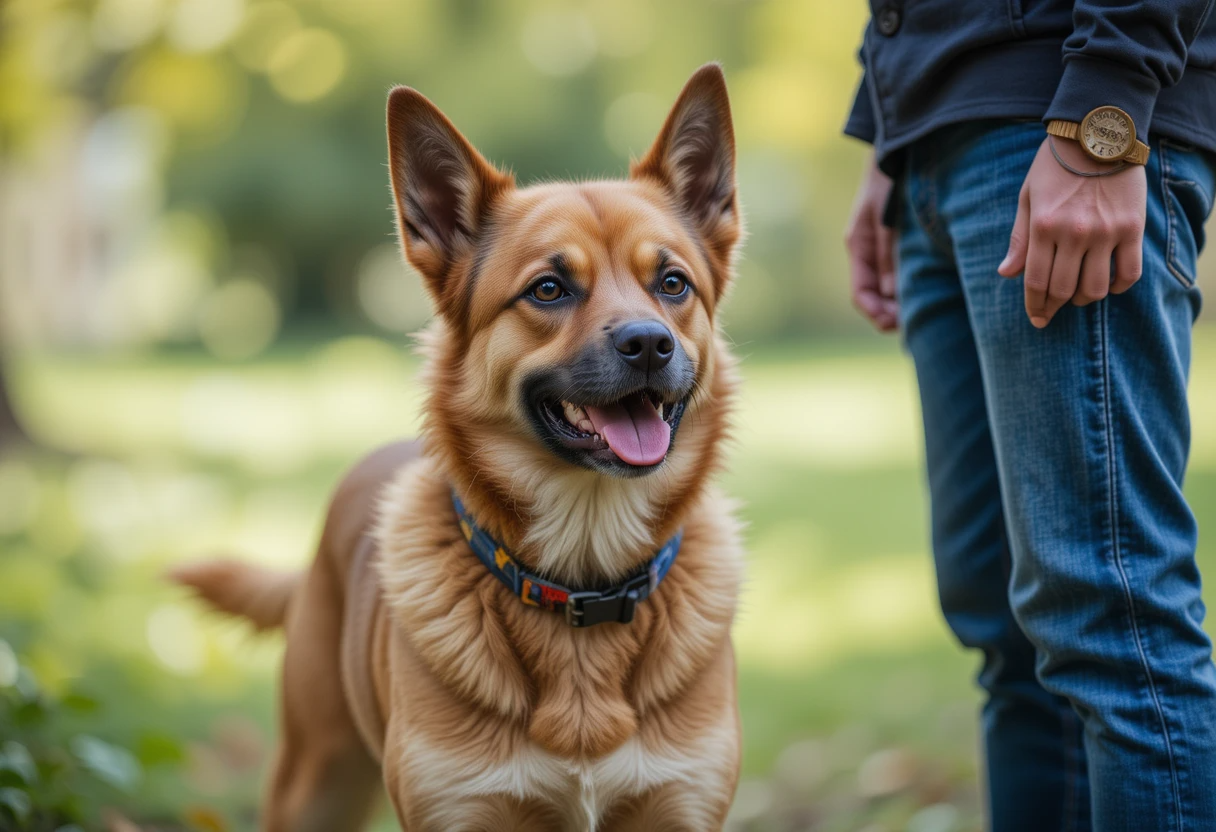Have you ever wondered, why does my dog follow me everywhere, even following you into the bathroom? This devoted shadowing behavior is something many dog owners experience daily. Whether you find it endearing or occasionally overwhelming, there’s much more to this habit than simple clinginess.
In this comprehensive guide, we’ll explore the fascinating reasons behind why your dog follows you everywhere, what it means for your relationship, and when this behavior might signal something that requires attention.
Why Following You Everywhere Is Part of Your Dog’s Evolutionary Bond

Dogs have been by our side for thousands of years, evolving from wild wolves to become our closest animal companions. This evolutionary journey has fundamentally shaped their behavior and instincts in ways that directly relate to their tendency to follow us.
From Wolves to Companions: The Pack Mentality
Dogs are descendants of wolves, which are pack animals that rely on group structure for survival. When we bring dogs into our homes, they simply transfer this pack mentality to their human family.
“Throughout history, dogs have been pack animals. When we remove dogs from their canine pack, they simply adopt their human pack instead. The same instincts that kick in with wild dogs are present in our canine companions,” explains veterinary experts at PetMD .
This natural instinct to stay close to the pack ensures safety, access to resources, and social connection—all evolutionary advantages that have been selected for over generations of domestication.
Domestication’s Profound Impact
The process of domestication itself has selected for dogs that are attentive to and bonded with humans. Dogs that were better at reading human cues, staying close, and forming attachments were more likely to be cared for and reproduce.
“It’s in their genes—dogs who were more responsive to humans and more likely to follow them were the ones humans chose to breed with,” notes canine behavior specialist Sally Morgan AKC.
The Chemistry of Connection: How Oxytocin Strengthens Your Bond with Your Dog

One of the most fascinating aspects of the human-dog relationship is the biological basis for the strong attachment that forms between species.
The “Love Hormone” Effect
When dogs and their owners interact in positive ways—through petting, playing, or even just making eye contact—both experience a surge in oxytocin, often called the “love hormone.” This hormone creates feelings of bonding, trust, and pleasure.
Research published in the Proceedings of the National Academy of Sciences showed that mutual gazing between humans and their dogs increases oxytocin levels in both parties, creating a positive feedback loop that strengthens attachment.
“When dogs interact with someone they like, the hormone oxytocin is released. Oxytocin is often referred to as the ‘love hormone’ and makes you feel that warm glow when you’re around someone you like,” explains The Kennel Club.
The Unique Human-Dog Connection
This oxytocin-mediated bond is remarkably similar to the connection between human parents and their children, suggesting that dogs have evolved to tap into our natural caregiving instincts. Research indicates that wolves don’t show the same oxytocin response when interacting with humans, highlighting how domesticated dogs have developed this unique ability to form deep cross-species bonds.
8 Key Reasons Your Dog Is Your Constant Companion
There are several specific reasons behind your dog’s shadowing behavior, and understanding them can provide valuable insights into your pet’s needs and psychology.

1. Companionship and Social Bonding
Dogs are inherently social creatures who crave interaction and companionship. Following you around is often simply their way of maintaining social connection.
“Just as we enjoy their companionship, they often like ours as well. And what better way to show it than to stick close to your buddy?” notes Dr. Sandra Mitchell, a veterinarian PetMD.
For many dogs, being near you is intrinsically rewarding, providing comfort and fulfilling their social needs.
2. Resource Access and Association
You are the gateway to everything your dog values—food, walks, play, and attention. Dogs quickly learn that sticking close to you increases their chances of gaining access to these valuable resources.
“Look at it from the dog’s point of view,” explains Erin Kramer, a professional certified dog trainer. “The person your dog is attached to is the road to everything wonderful and magical. The focus is on that person because of what they give access to.”
This resource-based attachment can be particularly strong with the person who most consistently feeds, walks, or plays with the dog.
3. Learned Behavior Through Reinforcement
Dogs are masters at pattern recognition. If following you has led to rewards in the past—whether that’s treats, attention, or playtime—they’ll continue the behavior.
“We often unconsciously reward this cute behavior by providing food or treats. Just beware that this can be a double-edged sword, as it makes your dog more likely to repeat the behavior,” cautions veterinary experts PetMD.
Even seemingly minor forms of attention, like speaking to your dog when they follow you, can reinforce the behavior.
4. Imprinting and Early Bonding
Dogs that were adopted as young puppies often imprint on their owners, viewing them as parental figures. This early imprinting creates a deep attachment that manifests as following behavior.
“If your dog was adopted as a young puppy, she may be imprinted on you, truly feeling like you are their dog mother,” explains Dr. Mitchell PetMD.
This imprinting is particularly strong in puppies who are separated from their mothers and siblings early and then form strong attachments to their human caregivers.
5. Monitoring and Protection Instincts
Many dogs, especially those from working or herding breeds, have instincts to monitor their family members’ whereabouts and activities.
“Working dogs, such as Border Collies and Labrador Retrievers, will follow people because they were bred to follow human orders and they are waiting for cues as to what should be done next,” notes Dr. Mitchell PetMD.
This monitoring behavior is often accompanied by protective instincts, with your dog wanting to ensure you’re safe at all times.
6. Anxiety and Insecurity
For some dogs, following behavior stems from anxiety or insecurity. They stay close because they feel safer and more secure when near you.
“Occasionally, dogs will stick close to your side if they are nervous, frightened, uncertain of strangers, or not feeling well,” explains veterinary experts PetMD.
This can be particularly evident during thunderstorms, fireworks, or other anxiety-provoking situations, when dogs naturally seek out their trusted humans for security.
7. Routine Anticipation
Dogs are creatures of habit who quickly learn your daily routines and schedules. They may follow you in anticipation of routine activities like walks, feeding times, or play sessions.
“Lots of pets learn to clue in on daily routines, like the fact that they are fed or walked at certain times. What better way to make sure you don’t forget than to be right there and waiting?” observes Dr. Mitchell PetMD.
8. Boredom or Lack of Stimulation
A dog with insufficient mental and physical stimulation may follow you simply because you’re the most interesting thing happening in their environment.
“Some dogs just get bored, so they figure that if you’re doing something, why not tag along? These dogs will often greatly benefit from more exercise,” suggests Dr. Mitchell PetMD.
Providing appropriate enrichment and exercise can help reduce this boredom-driven following behavior.
Learn more about becoming a psychiatric service dog trainer in 2025 by checking out our detailed guide How to Become a Psychiatric Service Dog Trainer in 2025 .
Breed-Specific Tendencies: The “Velcro Dogs”
While individual personality plays a significant role in determining how closely a dog follows their owner, certain breeds are genetically predisposed to this behavior.
Breeds Known for Their Shadowing Behavior
Some breeds are so renowned for their tendency to follow their owners that they’ve earned the nickname “Velcro dogs.” These include:
-
Vizslas: Often considered the ultimate Velcro dog, this Hungarian breed is bred to work closely with hunters and forms intense attachments to their owners.
-
Labrador Retrievers: These friendly family dogs are surprisingly clingy and thrive on human interaction.
-
German Shepherds: Loyal and protective, German Shepherds often monitor their family members’ whereabouts.
-
Border Collies: Their herding instincts make them naturally inclined to keep track of family members.
-
Australian Shepherds: These intelligent herding dogs are deeply devoted to their humans and driven to stay connected.
-
Golden Retrievers: Known for their affectionate nature, Goldens typically want to be wherever their family is.
-
Maltese: These small companion dogs were specifically bred to be lap dogs and human companions.
-
Pugs: These charming little dogs were historically bred as companions for Chinese royalty and remain people-oriented today.
“Some breeds are known to be ‘Velcro dogs’ and in fact, have been bred to be companions,” explains Dr. Mitchell. “Working dogs will follow people because they were bred to follow human orders and they are waiting for cues as to what should be done next.” PetMD
The Independent Spirits
In contrast, some breeds tend to be more independent and less likely to shadow their owners:
-
Terriers: Many terrier breeds were developed to work independently and may be more self-sufficient.
-
Hounds: Breeds like Beagles or Bloodhounds, bred to follow scents, may be more interested in environmental stimuli than constantly monitoring their humans.
-
Northern breeds: Dogs like Huskies and Malamutes can be more independent and less focused on constant human interaction.
When Following Becomes Concerning: Separation Anxiety vs. Normal Attachment

While some degree of following behavior is normal and healthy, excessive attachment can sometimes indicate an underlying problem.
Signs of Healthy Attachment vs. Separation Anxiety
Healthy attachment is characterized by:
- Following but remaining calm when separated
- Ability to relax independently
- No destructive behaviors when alone
- No excessive vocalization when separated
Separation anxiety, by contrast, involves:
- Panic when separated or when separation is anticipated
- Destructive behavior when alone
- Excessive barking, howling, or whining
- House soiling (in otherwise house-trained dogs)
- Physical symptoms like drooling or panting
- Escape attempts
“The big difference between separation anxiety and being a Velcro dog is anxiety itself. While Velcro dogs prefer to be glued to their owners, dogs with true separation anxiety actually panic when they’re away from their owners,” explains the American Kennel Club .
When to Seek Professional Help
Consider consulting a veterinarian or certified animal behaviorist if:
- Your dog’s following behavior suddenly intensifies without obvious cause
- Your dog shows signs of distress when separated from you
- Following behavior interferes with daily activities
- Your dog can’t settle when alone
- You observe destructive behavior or house soiling when alone
“If you feel that your dog follows you too much, or panics when they can’t follow you, it’s time to take action. It will help to consult your veterinarian for advice, particularly if your dog becomes overly anxious when separated from you,” advises Dr. Mitchell PetMD.
When Following Signals Health Concerns
A sudden change in following behavior can sometimes indicate underlying medical issues that warrant attention.
Medical Reasons for Increased Clinginess
Several health conditions can cause a dog to become more clingy or dependent:
-
Sensory Decline: “Perhaps your dog is starting to lose their hearing or vision. Or they have started to have joint problems, so they are less independent than they were,” explains Dr. Mitchell PetMD.
-
Cognitive Dysfunction: “Other dogs experience a mental decline—much like Alzheimer’s in people—that makes them become clingy,” notes veterinary experts PetMD.
-
Pain or Discomfort: Dogs may stay close to their trusted humans when feeling unwell or in pain.
-
Neurological Issues: Certain neurological conditions can cause personality changes, including increased dependence.
When to Consult Your Veterinarian
“If you notice that your senior dog has suddenly started to follow you around, or you see any other changes in their behavior, schedule a veterinary visit to look for the underlying problem,” advises Dr. Mitchell PetMD.
Any abrupt change in behavior, especially in older dogs, warrants a veterinary evaluation to rule out medical causes.
If you want to learn more about keeping your furry friend healthy, check out our guide on How to Improve Dog Gut Health Naturally Home Remedies
Creating a Healthy Balance: Managing Following Behavior

For many owners, a dog’s constant shadowing can become problematic, particularly if it creates safety concerns or limits independence for either party.
Strategies for Encouraging Independence
-
Gradual Separation Training: “Teaching your dog to stay in or on their place for 2, 3, 4, 5 all the way to 10 minutes if you can, even if they can see you,” recommends dog training experts on Reddit Reddit.
-
Create Safe Zones: “Leaving toys and treats near their dog bed can give your dog a place to settle down. Teach the stay and place commands, and give your dog attention for remaining on the dog bed,” suggests the AKC AKC.
-
Avoid Reinforcing Clingy Behavior: “If you switch your expectations and totally ignore your dog while they are following you and only pay attention or give treats once your dog has settled in another area, you will start to break the habit of trailing you to get something,” explains Dr. Mitchell PetMD.
-
Physical and Mental Stimulation: “Physical and mental exercise also may encourage a dog to settle down and relax. A dog with too much energy is more likely to be bored and restless and to follow you,” notes the AKC AKC.
-
Expand Their Social Circle: “If there are other adults in your household, have them walk the dog on a regular basis,” suggests the AKC, as this helps reduce fixation on a single person AKC.
Addressing Separation Anxiety
For dogs with true separation anxiety, a more structured approach may be necessary:
-
Counterconditioning: “Counterconditioning focuses on developing an association between being alone and good things, like delicious food,” explains the ASPCA.
-
Desensitization to Departure Cues: “Put on your boots and coat, and then just watch TV instead of leaving. Or pick up your keys, and then sit down at the kitchen table for a while,” suggests the ASPCA.
-
Graduated Departures: Systematically practice very short separations that don’t trigger anxiety, gradually increasing duration.
-
Professional Support: “For help designing and carrying out a desensitization and counterconditioning plan, consult a Certified Applied Animal Behaviorist (CAAB or ACAAB) or a board-certified veterinary behaviorist (Dip ACVB),” recommends the ASPCA for moderate to severe cases.
-
Medication: “The use of medications can be very helpful, especially for severe cases of separation anxiety. Some dogs are so distraught by any separation from their pet parents that treatment can’t be implemented without the help of medication,” notes the ASPCA.
The Bathroom Phenomenon: Why Dogs Follow You to the Bathroom
Perhaps one of the most commonly discussed aspects of dogs’ following behavior is their tendency to accompany owners to the bathroom—a behavior that often puzzles and amuses dog owners.
The Bathroom Mystery Explained
Several factors contribute to this peculiar behavior:
-
Curiosity and Scent Interest: “There are all kinds of things in the bathroom that smell intensely like their family members, and it’s great fun to explore these!” explains Dr. Mitchell PetMD.
-
Pack Instinct: In the wild, pack members are vulnerable during elimination. Your dog may instinctively want to provide protection or companionship during this time.
-
Routine Following: If they follow you everywhere else, why not the bathroom? For many dogs, this is simply an extension of their normal shadowing behavior.
-
Separation Prevention: Dogs quickly learn that bathroom doors often close, separating them from their beloved humans—something they may actively try to prevent.
Setting Boundaries
If bathroom following becomes problematic, the same independence-building strategies apply. Consistent boundaries and positive reinforcement for respecting personal space can help establish more comfortable routines for both you and your pet.
If your puppy often pees when excited, check out our helpful guide on How to Stop Puppy Excited Pee Quickly: Proven Tips to End Excitement Urination for easy and effective solutions.
Embracing the Bond: The Positive Side of Having a Canine Shadow

While this article has addressed various concerns and management strategies related to following behavior, it’s important to acknowledge and celebrate the positive aspects of this devoted companionship.
The Benefits of Close Human-Dog Relationships
-
Enhanced Well-being: Studies have shown that positive interactions with dogs can reduce stress hormones and blood pressure while increasing beneficial neurochemicals like oxytocin, serotonin, and dopamine.
-
Constant Companionship: Having a loyal friend who chooses to be near you can provide comfort, reduce loneliness, and offer a sense of being valued and needed.
-
Security and Safety: Dogs alert us to potential dangers and often serve as both physical and emotional protectors.
-
Mindfulness and Presence: A dog’s tendency to live in the present moment can help ground us and remind us to appreciate the simple joys of daily life.
Finding Your Personal Balance
The ideal human-dog relationship involves mutual respect for needs and boundaries while maintaining a strong bond. As Dr. Mitchell wisely notes, “In the ideal situation, your dog follows you as a companion but not to the point of being annoying, and at the same time, you can separate yourself from your dog without producing anxiety” PetMD.
Each owner-dog relationship is unique, and finding the right balance that works for both of you is key to a harmonious life together.
FAQs
When your dog follows you and stares intently, they’re often communicating with you. This behavior typically indicates attention-seeking, anticipation of something (like food or a walk), expressing affection, or simply monitoring your activities. The staring is usually a form of non-verbal communication—your dog’s way of trying to understand your intentions or signal their needs. This behavior is particularly common in breeds selected for working closely with humans, as they’re naturally attuned to human cues and expressions. Why does my dog follow me everywhere and stare at me?
Why does my dog follow me everywhere but no one else?
Dogs often choose one primary person to follow based on who fulfills their needs most consistently. This selective following behavior usually indicates that you are the primary caregiver who feeds, walks, and plays with the dog, or the person who gives out treats most frequently. Early bonding experiences and positive reinforcement history are significant factors. As Erin Kramer, a professional dog trainer explains, “The person your dog is attached to is the road to everything wonderful and magical. The focus is on that person because of what they give access to.”
Why does my dog follow me to the toilet?
This common behavior has multiple explanations. First, dogs are naturally curious about strong scents, and bathrooms contain many intense odors that interest them. Second, pack animals instinctively stay together, even during vulnerable moments. Third, dogs form routines and simply expect to accompany you everywhere. As Dr. Mitchell explains, “There are all kinds of things in the bathroom that smell intensely like their family members, and it’s great fun to explore these!” Additionally, many dogs have learned that closed doors mean separation, so following you to the bathroom helps them prevent being left alone.
Why is my dog so close to me all of a sudden?
A sudden increase in following or clingy behavior should be noted as it may indicate underlying issues. Common causes include:
- Health problems or pain seeking comfort
- Loss of senses (especially in older dogs)
- Environmental changes causing anxiety
- Response to your emotional state (dogs can sense stress or illness)
- Cognitive decline in senior dogs
As PetMD advises, “If your dog has always been a confident, independent dog and has suddenly become clingy, there’s a good chance they are trying to tell you something… Any time a dog’s behavior changes markedly and suddenly, it is time to schedule a checkup.”
Why does my dog follow me and not my husband/partner?
This preference often develops based on who most consistently provides care, food, exercise, play, and positive reinforcement. Dogs naturally bond more strongly with the person who meets their needs most frequently and consistently. This doesn’t mean your dog doesn’t love other family members—they simply recognize their primary provider. History matters too—if you were the one who originally brought the dog home or spent the most time with them during their adjustment period, that early bonding can establish a lasting preference. The good news is that encouraging other family members to participate in feeding, walking, and playing with your dog can help create more balanced attachments over time.
Conclusion
Your dog’s tendency to follow you everywhere is a multifaceted behavior rooted in evolution, domestication, and the unique bond you’ve formed together. While sometimes this shadowing can become problematic—particularly if it stems from anxiety or interferes with daily life—it most often represents one of the most beautiful aspects of the human-dog relationship: devoted companionship.
By understanding the various factors that contribute to following behavior, you can better address any concerns while appreciating the loyalty and affection it usually represents. Whether your dog is a classic “Velcro dog” or simply enjoys your company, this behavior is a testament to the remarkable cross-species bond we’ve cultivated with canines over thousands of years.
With patience, training, and respect for both your needs and your dog’s, you can cultivate a balanced relationship that honors the close connection while maintaining healthy independence for both of you—the best of both worlds for human and canine alike.
If you’re looking to keep your home fresh and clean, check out our detailed guide on the Best Air Purifier for Homes with Multiple Dogs in 2025. It covers everything you need to know to choose the right purifier for pet-friendly homes.

